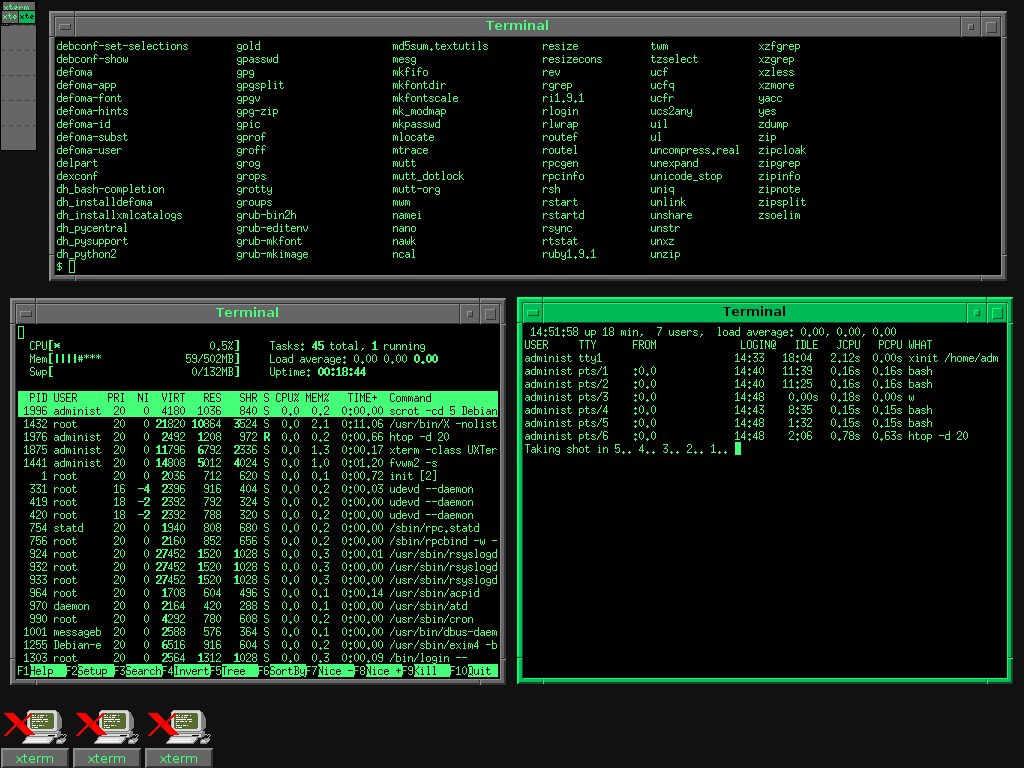|
Razor-qt
Razor-qt is a discontinued free and open-source desktop environment. It was intended as a lightweight desktop environment based upon the Qt application framework, and was "tailored for users who value simplicity, speed, and an intuitive interface." Development of Razor-qt has ceased, as it has merged with LXDE's Qt port to form LXQt. Overview Razor-qt was still in the early stages of development. , the environment included a panel viewer and switcher, a desktop, an application launcher, a settings center and sessions. These components could be enabled or disabled by the user. Razor-qt could be used with any modern X window manager such as Openbox, fvwm2, or KWin. The memory consumption of Razor-qt was slightly above LXDE, using 114 MiB in a reviewer's test while LXDE used 108 MiB. Merge with LXDE After LXDE developer Hong Jen Yee ported PCManFM to Qt in early 2013, he and other interested developers discussed a potential collaboration with Razor-qt, another open-sour ... [...More Info...] [...Related Items...] OR: [Wikipedia] [Google] [Baidu] |
LXQt
LXQt is a free and open source lightweight desktop environment. It was formed from the merger of the LXDE and Razor-qt projects. Like its GTK predecessor LXDE, LXQt does not ship or develop its own window manager, instead LXQt lets the user decide which (supported) window manager they want to use. Linux distributions commonly default LXQt to Openbox or xfwm4 or kwin. History Dissatisfied with GTK 3, LXDE maintainer Hong Jen Yee experimented with Qt in early 2013 and released the first version of a Qt-based PCMan File Manager on 26 March 2013. He clarified, though, that this means no departure from GTK in LXDE, saying "The GTK and Qt versions will coexist". He later ported LXDE's Xrandr front-end to Qt. On 3 July 2013 Hong Jen Yee announced a Qt port of the full LXDE suite, and on 21 July 2013, Razor-qt and LXDE announced that they had decided to merge the two projects. This merge meant that the GTK and the Qt versions coexisted in the short term, but eventually development ... [...More Info...] [...Related Items...] OR: [Wikipedia] [Google] [Baidu] |
LXDE
LXDE (abbreviation for Lightweight X11 Desktop Environment) is a free desktop environment with comparatively low resource requirements. This makes it especially suitable for use on older or resource-constrained personal computers such as netbooks or system on a chip computers. Overview LXDE is written in the C programming language, using the GTK 2 toolkit, and runs on Unix and other POSIX-compliant platforms, such as Linux and BSDs. The LXDE project aims to provide a fast and energy-efficient desktop environment. In 2010, tests suggested that LXDE 0.5 had the lowest memory-usage of the four most-popular desktop environments of the time (the others being GNOME 2.29, KDE Plasma Desktop 4.4, and Xfce 4.6), and that it consumed less energy, which suggests mobile computers with Linux distributions running LXDE 0.5 drained their batteries at a slower pace than those with other desktop environments. LXDE uses rolling releases for its individual components (or for groups of comp ... [...More Info...] [...Related Items...] OR: [Wikipedia] [Google] [Baidu] |
Comparison Of X Window System Desktop Environments
A desktop environment is a collection of software designed to give functionality and a certain look and feel to an operating system. This article applies to operating systems which are capable of running the X Window System, mostly Unix and Unix-like operating systems such as Linux, Minix, illumos, Solaris, AIX, FreeBSD and Mac OS X. Microsoft Windows is incapable of natively running X applications; however, third-party X servers like Cygwin/X, Exceed, or Xming are available. Technical elements of a desktop environment A desktop environment (DE) can be broken up into several components that function independently and interact with one another to provide the look and feel and functionality of the desktop environment. A fundamental part of a DE is the window manager or WM. A window manager creates a certain way for application windows to present themselves to the user. It manages the various application windows, keeping track of which ones are open and providing features to s ... [...More Info...] [...Related Items...] OR: [Wikipedia] [Google] [Baidu] |
Desktop Environment
In computing, a desktop environment (DE) is an implementation of the desktop metaphor made of a bundle of programs running on top of a computer operating system that share a common graphical user interface (GUI), sometimes described as a graphical shell. The desktop environment was seen mostly on personal computers until the rise of mobile computing. Desktop GUIs help the user to easily access and edit files, while they usually do not provide access to all of the features found in the underlying operating system. Instead, the traditional command-line interface (CLI) is still used when full control over the operating system is required. A desktop environment typically consists of icons, windows, toolbars, folders, wallpapers and desktop widgets (see Elements of graphical user interfaces and WIMP). A GUI might also provide drag and drop functionality and other features that make the desktop metaphor more complete. A desktop environment aims to be an intuitive way for the user to ... [...More Info...] [...Related Items...] OR: [Wikipedia] [Google] [Baidu] |
Desktop Environment
In computing, a desktop environment (DE) is an implementation of the desktop metaphor made of a bundle of programs running on top of a computer operating system that share a common graphical user interface (GUI), sometimes described as a graphical shell. The desktop environment was seen mostly on personal computers until the rise of mobile computing. Desktop GUIs help the user to easily access and edit files, while they usually do not provide access to all of the features found in the underlying operating system. Instead, the traditional command-line interface (CLI) is still used when full control over the operating system is required. A desktop environment typically consists of icons, windows, toolbars, folders, wallpapers and desktop widgets (see Elements of graphical user interfaces and WIMP). A GUI might also provide drag and drop functionality and other features that make the desktop metaphor more complete. A desktop environment aims to be an intuitive way for the user to ... [...More Info...] [...Related Items...] OR: [Wikipedia] [Google] [Baidu] |
Software Design
Software design is the process by which an agent creates a specification of a software artifact intended to accomplish goals, using a set of primitive components and subject to constraints. Software design may refer to either "all the activity involved in conceptualizing, framing, implementing, commissioning, and ultimately modifying complex systems" or "the activity following requirements specification and before programming, as ... na stylized software engineering process." Software design usually involves problem-solving and planning a software solution. This includes both a low-level component and algorithm design and a high-level, architecture design. Overview Software design is the process of envisioning and defining software solutions to one or more sets of problems. One of the main components of software design is the software requirements analysis (SRA). SRA is a part of the software development process that lists specifications used in software engineering. If ... [...More Info...] [...Related Items...] OR: [Wikipedia] [Google] [Baidu] |
PCManFM
PCMan File Manager (PCManFM) is a file manager application, developed by Hong Jen Yee () from Taiwan, which is meant to be a replacement for GNOME Files, Dolphin and Thunar. PCManFM is the standard file manager in LXDE, also developed by the same author in conjunction with other developers. Since 2010, PCManFM has undergone a complete rewrite from scratch; build instructions, setup and configuration have changed in the process. Released under the GNU General Public License, PCManFM is free software. It follows the specifications given by Freedesktop.org for interoperability. Dissatisfied with GTK3, Hong Jen Yee experimented with Qt in early 2013 and released the first version of a Qt-based PCManFM on . He clarified, though, that does not indicate any departure from GTK in LXDE, saying: "The GTK and Qt versions will coexist". The new PCManFM-Qt is a core component of LXQt. In 2020 the Arch Linux community ported PCManFM to GTK 3. Features PCManFM's features include: * Full GVf ... [...More Info...] [...Related Items...] OR: [Wikipedia] [Google] [Baidu] |
Porting
In software engineering, porting is the process of adapting software for the purpose of achieving some form of execution in a computing environment that is different from the one that a given program (meant for such execution) was originally designed for (e.g., different CPU, operating system, or third party library). The term is also used when software/hardware is changed to make them usable in different environments. Software is ''portable'' when the cost of porting it to a new platform is significantly less than the cost of writing it from scratch. The lower the cost of porting software relative to its implementation cost, the more portable it is said to be. Etymology The term "port" is derived from the Latin '' portāre'', meaning "to carry". When code is not compatible with a particular operating system or architecture, the code must be "carried" to the new system. The term is not generally applied to the process of adapting software to run with less memory on the sam ... [...More Info...] [...Related Items...] OR: [Wikipedia] [Google] [Baidu] |
KWin
KWin is a window manager for the X Window System and a Wayland compositor. It is released as a part of KDE Plasma 5, for which it is the default window manager. KWin can also be used on its own or with other desktop environments. KWin can be configured by scripting using QML or QtScript, both of which are based on ECMAScript. History Look and feel There are many window decorations for KWin, including the current default Breeze (shown below), the previous default Oxygen, Microsoft Windows-like Redmond, and Keramik. Compositing Currently available compositing backends include OpenGL 1.2, OpenGL 2.0, OpenGL 3.1 and OpenGL ES 2.0. Included effects As of KDE 4.3 the following effects are built-in: Accessibility Appearance Candy Focus Tools Window management See also *Comparison of X window managers This article compares variety of different X window managers. For an introduction to the topic, see X Window System. General information ... [...More Info...] [...Related Items...] OR: [Wikipedia] [Google] [Baidu] |
Fvwm2
The F Virtual Window Manager is a virtual window manager for the X Window System. Originally a twm derivative, FVWM has evolved into a powerful and highly configurable environment for Unix-like systems. History In 1993, during his work analyzing acoustic signatures for the United States Department of Defense, Robert Nation began hacking twm with the intent of simultaneously reducing memory usage and adding support for virtual desktops. Already known for his rxvt terminal emulator, Nation worked on reducing the memory consumption of his new window manager. Deciding to test FVWM's reception, on June 1, 1993, he bundled it with a rxvt release. In 1994 Rob Nation stopped developing FVWM and made Charles Hines the maintainer. Rob Nation's last release of FVWM was fvwm-1.24r. The post-Rob Nation version of FVWM uses a different configuration file format and has a significantly different architecture. Many Linux distributions, as a result, distributed both fvwm-1.24r and later relea ... [...More Info...] [...Related Items...] OR: [Wikipedia] [Google] [Baidu] |
Razor Logo
A razor is a bladed tool primarily used in the removal of body hair through the act of shaving. Kinds of razors include straight razors, safety razors, disposable razors, and electric razors. While the razor has been in existence since before the Bronze Age (the oldest razor-like object has been dated to 18,000 BC), the most common types of razors currently used are the safety razor and the electric razor. History Razors have been identified from many Bronze Age cultures. These were made of bronze or obsidian and were generally oval-shaped, with a small Tang (tools), tang protruding from one of the short ends.Warwickshire County Council: New Prehistoric Archaeology Objects "Even furthe ... [...More Info...] [...Related Items...] OR: [Wikipedia] [Google] [Baidu] |



